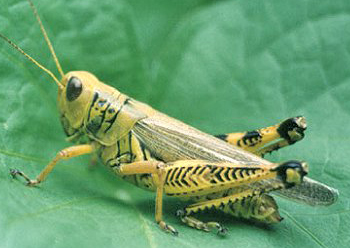acrido-, acrid-, acris-
(Greek: grasshopper, grasshoppers; locust, locusts; cricket, crickets)
Acridids, or grasshoppers with short antennae, are related to the crickets (Gryllidae) and to the long-horned grasshoppers and katydids (Locustidae).
2. Any of various cicadas: The seventeen-year locust is considered to be an acridid.
Extending her abdomen to about twice its normal length, a female locust deposits a pod of some 70 rice-size eggs four inches deep in moist sand.
Sensors at the end of her tail test moisture, salinity, temperature, and the softness of the ground to ensure that conditions are proper for laying her eggs.
To hatch, the eggs must absorb their weight in water, ideally in the first five days. During the last weeks of her four-month life, the gregarious female lays three times, usually a total of about 200 eggs.
Big-eyed hoppers hatch from the warm sands. The locusts promptly shed their natal skins, turn dark after about two hours in the sun, and within a few days they begin to move off in dense swarms.
2. The consumption of grasshoppers: Acridophagy refers to the ingestion of grasshoppers, locusts, or crickets that are protein rich foods in certain austere climatic regions.
2. Referring to the consumption of grasshoppers, locusts, and/or crickets: It is said that there are acridophagoous tribes in Africa that eat grasshoppers as part of their diet.
Storks flash white against the chocolate brown water as they bank in and out of the locusts; then come weaver birds and wagtails, picking at the remaining locusts.
The attackers gorge themselves until they can no longer fly. Some of them settle on banyan trees or fall to the ground.
There are cattle egrets, with sagging stomachs, that stagger in the dust trying to take off. Some of them manage a few limp flaps of their wings, then they topple on their sides, while the rest of the locusts continue flying on with no further molestations.
With serrated jaws rasping from side to side, adult locusts daily eat the equivalent of their weight, .04 to .09 of an ounce. Yet they are capable of living four days without feeding by surviving on stored fat.
Typical of the countless billions that impoverish African and Asian farmers, these voracious eaters feast on crops of leaves, stalks, and tons of grains.
Most of a locust's natural enemies are primarily beetles, flies, and wasps that are neither numerous enough on the ground nor mobile enough in the air to challenge vast swarms of locusts.
Birds regularly attack locusts, but their effect is only marginal. African kites drop from the sky and they barrel-roll through the swarm, grabbing locusts with snaps of their beaks, then they climb high to peel off again.
The term acrido- in the entries related to locusts or grasshoppers is derived from Acrididae, which consists of the locusts and true grasshoppers.

Lynn's sister was an acridophobe who had a horror of grasshoppers when she was young.
Around the world there are hundreds of species of grasshoppers which is a group that includes crickets and locusts.
Grasshoppers are difficult to see in the grass where they live, but they can often be heard since each species has a characteristic song, produced by rubbing the wings or legs together.
The song is used by males to attract females and, less frequently, by females to attract males.

